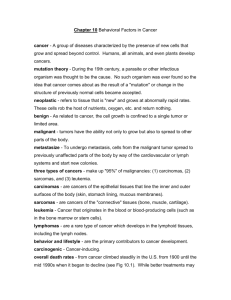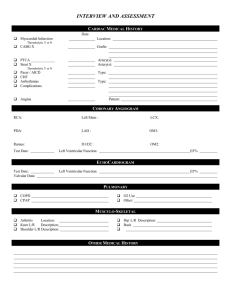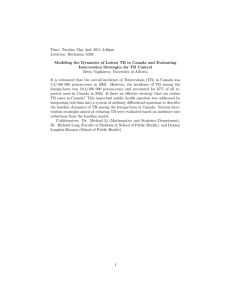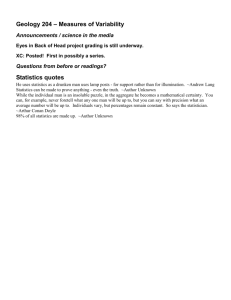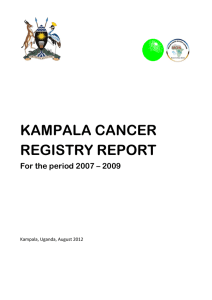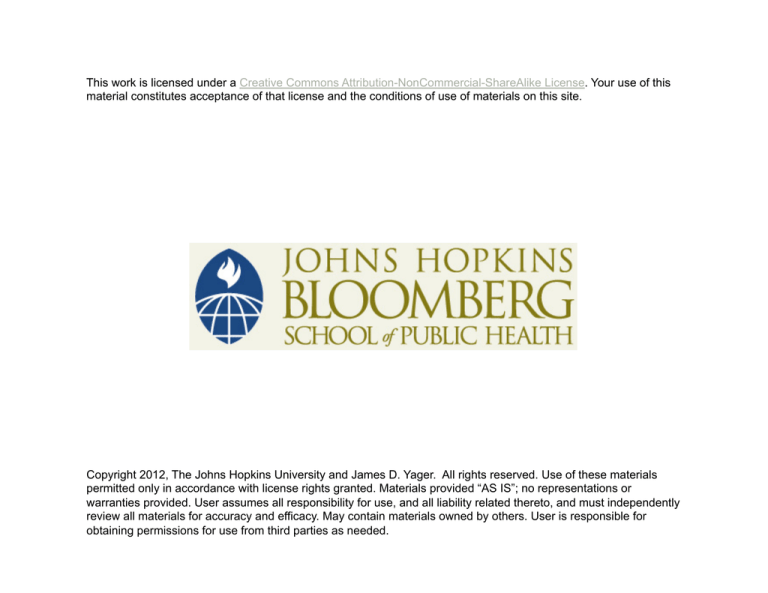
This work is licensed under a Creative Commons Attribution-NonCommercial-ShareAlike License. Your use of this
material constitutes acceptance of that license and the conditions of use of materials on this site.
Copyright 2012, The Johns Hopkins University and James D. Yager. All rights reserved. Use of these materials
permitted only in accordance with license rights granted. Materials provided “AS IS”; no representations or
warranties provided. User assumes all responsibility for use, and all liability related thereto, and must independently
review all materials for accuracy and efficacy. May contain materials owned by others. User is responsible for
obtaining permissions for use from third parties as needed.
Environmental Carcinogenesis
James D. Yager, PhD
Bloomberg School of Public Health
Carcinogenic Process
3
Lecture Outline
Cancer
A - What Causes It?
B – Where Does It Occur & What Is It
C – Mechanisms – Multiple Stages
D – Genes Whose Mutation Can Lead To
Initiation
E – Promotion and Progression
F – Lung Cancer
4
Section A
Cancer - What causes it?
• Gene-Environment Interaction
Epidemiological evidence for a role of environment/life-style
and endogenous factors
• Historical perspective
• Prevalence differences
• Carcinogenic “Agents”
Historical Perspective
1713: Ramazzini
–
Nuns exhibited a higher frequency
of breast cancer; attributed to
celibate life
1761: Hill
–
Associated the use of tobacco
snuff with cancer of the nasal
passages
1775: Pott
–
Noted the occurrence of sootrelated cancer in chimney sweeps
1894: Unna
–
Associated sunlight
exposure with skin cancer
1895: Rehn
–
Associated occupational
exposure to aromatic
amine dyes with bladder
cancer
1915: Ichikawa
–
First experimental
production of tumors in
animals (application of coal
tar to ears of rabbit)
6
Incidence Differences
7
Incidence Differences
“Cancer occurs in every country..” BUT “…there are wide
geographic variations in incidence”* rates
– See GLOBOCAN 2008 (http://globocan.iarc.fr/)
• ASR(W) = Age – World Standardized Incidence Rate
– Incidences of specific tumor types can vary up to
several hundred-fold
There are large differences in tumor incidences within
populations of a single country
*http://rex.nci.nih.gov/NCI_Pub_Interface/raterisk/rates24.html
Winn, D.M. Nature Reviews – Cancer, 5/12, 986, 2005
8
Cancer Incidence in US by County
http://statecancerprofiles.cancer.gov/map/map.withimage.php?99&001&055&00&2&1&0&1&6&0#map
9
The Causes of Cancer
Quantitative Estimates
of Avoidable Risks of Cancer in the United States
By comparing cancer incidence in the U.S.
and the lowest incidence areas of the
world, Doll and Peto concluded that:
– 80% of male cancers and 77% of
female cancers are potentially avoidable
10
Carcinogenic Agents
Exogenous Chemicals
Inorganic:
–
Organic:
–
Arsenic, cadmium,
chromium, nickel, etc.
Endogenous Agents
Polycyclic aromatic
hydrocarbons,
chlorinated
hydrocarbons,
heterocyclic amines,
aflatoxin, benzene,
nitrosamines,
formaldehyde, etc.
Estrogen:
–
breast, prostate
Immune system – function/
dysfunction
Diethylstilbestrol,
ethinyl estradiol,
tamoxifen, HRT (equine
estrogen equilenin +
progestin), etc.
–
Viruses
–
Physical agents
X-rays:
–
–
breast, leukemia
Ultraviolet light:
Hormones:
–
Biological agents
Bacteria
skin: non-melanoma
and melanoma
Asbestos:
–
lung
–
Helicobacter pylori
(Ex.: Stomach
cancer)
RNA tumor viruses
• Human T-cell
leukemia virus
—HIV/HTLV)
DNA tumor viruses
• Hepatitis B and
C: liver cancer;
• Papilloma
viruses: cervical
cancer;
• Epstein-Barr
virus: Burkitt’s
lymphoma
11
Etiologies of the World’s Leading Cancers*
Cancer site
Infection
Inflammation
Exposure
probably
Lung/Bronchus
Breast
Colon/Rectum
Stomach
Liver
Prostate
Uterine Cervix
Esophagus
Bladder
definitely
H. pylori
definitely
Hep. viruses
definitely
probably
HPV
probably
maybe
S. haematobium maybe
smoking
estrogens, diet
diet
diet
diet (aflatoxin B1)
diet, androgens? estrogen?
smoking
smoking, diet
smoking
All sites
often
almost always
almost always
(excluding skin)
*Ordered by incidence as reported by the World Health Organization
International Agency for Research on Cancer (IARC); see www.iarc.fr
more than 70% of all cancer cases can be prevented
Slide provided by Dr. W. Nelson, JH SKCC
Proportion of Cancer Deaths Estimated to be
Attributed to Environmental Influences
13
What Causes Cancer?
• Breathing
• Eating
• Drinking
• Sex
• Doctors
• Parents
HPV
Slide provided by Dr. W. Nelson, JH SKCC
Key Points - Section A
Cancer is a consequence of gene-environment
interactions
– Historical examples of specific exposures/specific
cancers
– Migrant populations assume cancer rate of new
location
– Large differences in incidence within regions of a
country
– Chemicals, viruses, and radiation can be carcinogenic
– Key environmental factors include diet, smoking/env
tobacco smoke, infectious agents
– Endogenous factors also contribute to cancer
Environmental factors may contribute to 3/4 of all human
cancers
15

